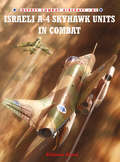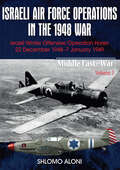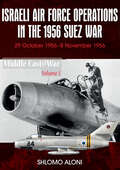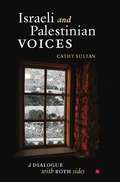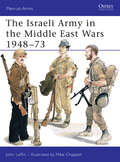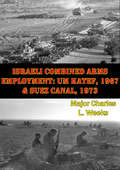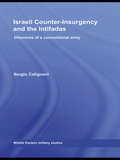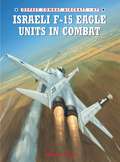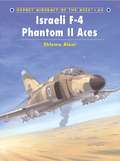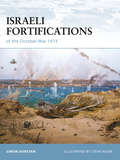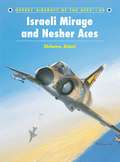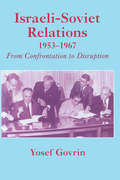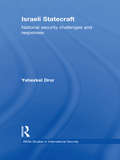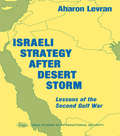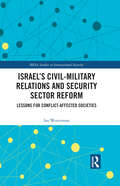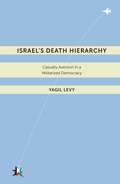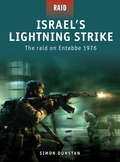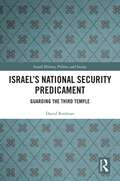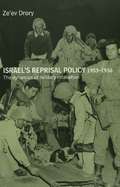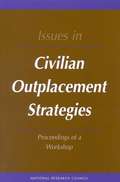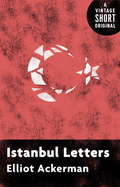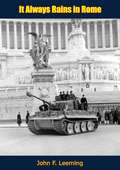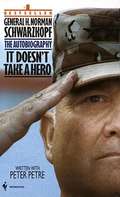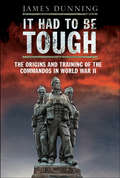- Table View
- List View
Israeli A-4 Skyhawk Units in Combat
by Jim Laurier Shlomo AloniThe light and agile A-4 Skyhawk was the first modern American jet to be offered to the Israeli Air Force, marking the point where the US took over from France as Israel's chief military supplier. Deliveries began too late for the A-4 to fight in the Six-Day War (1967), but it soon formed the backbone of the IAF's ground-attack force. From 1969 to 1970 it flew endless sorties against Egyptian forces in the War of Attrition (1967-1970). Then, during the Yom Kippur War (1973), five squadrons of A-4s saw combat and 50 planes were lost as they battled against the Arab armored onslaught. Using previously unpublished first-hand accounts and rare photography from the IAF archives and pilots' private collections, Shlomo Aloni tells the definitive history of the IAF's A-4 squadrons, including the story of Ezra "BABAN" Dotan who became an ace with an unique double-kill of MiG17s.
Israeli Air Force Operations in the 1948 War: Israeli Winter Offensive Operation Horev 22 December 1948–7 January 1949 (Middle East at War #2)
by Shlomo AloniOperation HOREV – the Israeli winter offensive from December 1948 until January 1949 – practically ended Israel’s War for Independence (also known as the 1948 Arab-Israeli War), with an Israeli victory that forced Egypt to seek ceasefire and to negotiate a settlement with the fledgling nation. From HOREV Day 1 on 23 December 1948 until HOREV Day 16 on 7 January 1949, this title presents Israeli Air Force missions during Operation HOREV in heretofore unseen depth and detail. This title chronicles Israeli Air Force sorties during Operation HOREV; from Austers and Pipers to C-46s and C-47s; from Messerschmitts, Spitfires and P-51s to Beaufighters and B-17s; Israel Air Force operations are detailed spanning the timeline of the conflict down to every unearthed sortie in depth, and shown in a way that Israeli Air Force operations during Operation HOREV had never been presented before. This level of detail has been made possible by extensive use of contemporary documentation. The detailed text is supported by numerous photographs and color profiles. Middle East@War - following on from our highly successful Africa@War series, Middle East@War replicates the same format - concise, incisive text, rare images and high quality color artwork providing fresh accounts of both well-known and more esoteric aspects of conflict in this part of the world since 1945.
Israeli Air Force Operations in the 1956 Suez War: 29 October–8 November 1956 (Middle East at War #3)
by Shlomo AloniBy participating in 1956 Suez Crisis Israel exploited an opportunity to join forces with France and the United Kingdom in an attack against Egypt in order to accomplish diplomatic, military and political objectives: to open the Red Sea international shipping lane to ships sailing from and to Eilat; to strengthen its alliance with France; to end – or at least to scale down – Egyptian hosted Palestinian terror attacks against Israel; to launch a preventive war in order to crush Egyptian military power before its completion of the transition to Soviet weapons could tempt Egypt to attack Israel and in order to accomplish a profound victory to deter Egypt from pursuing a another round of war policy. Operation KADESH was the Israeli part in the Anglo-French attack and this title chronicles Israeli Air Force operations along the timeline of Operation KADESH – from day 1 on 29 October 1956 until day 11 on 8 November 1956 – in thus far unmatched depth and detail; all known Israel Air Force missions and sorties are listed and described and all air combats between Israeli Mysteres and Egyptian MiGs and Vampires are presented and analyzed. The large variety of aircraft flown – Dassault Mysteres, Dassault Ouragans and Gloster Meteors; B-17 Flying Fortresses, P-51 Mustangs and De Havilland Mosquitoes; T-6 Texans (Harvards) and T-17 Kaydets (Stearmans); Nord 2501 Noratlases, C-47 Skytrains (Dakotas), Pipers and Consuls and even a pair of Sikorsky S-55 helicopters – are all covered in this title, which presents Israeli Air Force operations during the Suez War in a depth and detail unseen in previous publications. The text is supported by numerous photographs and color profiles. Middle East@War - following on from our highly successful Africa@War series, Middle East@War replicates the same format - concise, incisive text, rare images and high quality color artwork providing fresh accounts of both well-known and more esoteric aspects of conflict in this part of the world since 1945.
Israeli and Palestinian Voices: A Dialogue with Both Sides
by Cathy SultanPart travelogue, part history, part sociological investigation, Israeli and Palestinian Voices begins with a fascinating account of Ms. Sultan's determined research trip to Jerusalem and Ramallah to interview many individuals on both sides of the conflict whose voices are seldom heard. <P><P>With her artificial metal knees and indomitable spirit, this American housewife braved checkpoints, barbed wire, and Merkur tanks to visit her informants.These illuminating, detailed interviews are followed by an historical primer for readers on the conflict's growth to its present standoff. Israeli and Palestinian Voices is a work for the interested layperson, a book to open eyes to the human realities of life in Israel-Palestine and to clearly show the thinking on all sides.
The Israeli Army in the Middle East Wars 1948-73
by Mike Chappell John LaffinIsrael assumes in advance that defeat in war means an end to the Jewish nation, and it wages war accordingly. This fact influences the Israeli approach to its army and to the strategy, tactics, training and conduct of war. Surrounded by hostile nations, Israel has fought six victorious wars between 1948 and 1973. For a force which began as an irregular, impoverished and improvised group, this is a formidable record. Backed by plenty of photographs and eight full page colour plates, this fine text examines the six wars fought between 1948-73, including the extraordinary Israeli victory of 1967.
Israeli Combined Arms Employment: Um Katef, 1967 & Suez Canal, 1973
by Major Charles L. WeeksThe next desert war the United States fights could be against an enemy more comparable to us in training, motivation, and technology than the recent conflict in the Persian Gulf. The Middle East is a dangerous part of the world where we have limited experience in the use of high technology weapons, or in large-scale combat even given the recent war against Iraq. Since we have limited experience in these areas, this thesis analyzes two of the most recent historical examples of such combat from the 1967 and 1973 Arab-Israeli Wars to reveal conclusions useful to U. S. war fighters.This thesis examines the Battle of Um Katef, Abu Ageila from the 1967 War, and the Sinai Campaign from the 1973 War. They were examined primarily from secondary sources, using the U. S. Army battlefield operating systems, as the framework to evaluate success or failure. The resulting keys to success or reasons for failure were then further evaluated against the four tenets of U. S. Airland Battle Doctrine (Agility, Initiative, Depth, and Synchronization).The result of this investigation is a number of conclusions regarding modern combined arms combat. These conclusions are categorized as strengths or weaknesses and presented as lessons learned. Surprisingly enough, none of the lessons learned proved to be environment specific.
Israeli Counter-Insurgency and the Intifadas: Dilemmas of a Conventional Army (Middle Eastern Military Studies)
by Sergio CatignaniThis volume analyzes the conduct of the Israel Defence Forces (IDF) counter-insurgency operations during the two major Palestinian uprisings (1987-1993 and 2000-2005) in the Territories of the West Bank and Gaza Strip. It employs primary and secondary resources to produce a comprehensive analysis on whether or not the IDF has been able to adapt it
Israeli F-15 Eagle Units in Combat
by Chris Davey Shlomo AloniDiplomacy, politics and national trauma has dominated the frontline career of the Israeli F-15 to date. In the wake of the losses suffered in the October 1973 Yom Kippur War, the Israeli government opted for technology in an effort to reassure a traumatised population that they would never suffer a surprise attack from the air again. Despite Israel Defense Force Air Force (IDF/AF) interceptors having performed extremely successfully during the Yom Kippur War, they did not achieve the kind of results that allowed Israel to achieve future deterrence. The nation was not only looking for weapons that would win a war, but that would also prevent it in the first place. Post-Yom Kippur diplomacy enabled Israel to purchase the F-15 Eagle, which was then the world's best air-to-air fighter. For the first time in its history the IDF/AF could operate a fighter that was a full generation ahead of all opposing interceptors in the region. The first 'Kill' F-15 Baz (Buzzard) arrived in Israel in December 1976, and three years later it got the chance to prove its worth in combat. Israeli Baz pilots were credited with 12.5 kills between 1979 and 1981, with 33 victories following during the June 1982 Lebanon War. A further 4.5 kills followed in post-Lebanon War skirmishes. Despite all of this combat, no Israeli F-15 has ever been lost to enemy action. Once the jet secured air superiority and deterrence had been achieved along the Israeli borders, the IDF/AF went on to explore the Baz's long-range attributes and as air-to-ground capability. As an example of the former, Israeli F-15s escorted F-16 strike aircraft all the way to Iraq's nuclear reactor in June 1981, and in its bomber role, the type flew the IDF/AF's longest ever attack mission in October 1985 when it bombed the PLO headquarters in Tunis. Diplomacy prevailed again in the 1990s when the US government agreed to supply the IDF/AF with the F-15I Ra'am (Thunder) to fulfill the long-range surface-to-surface missile (SSM) mission post-Desert Storm. These aircraft also acted as a counter-balance to the sale of the F-15S to Saudi Arabia. A follow-on to the F-15I purchase was the development of the Improved Baz Avionics Upgrade Program, which saw the integration of many of the F-15I features into the older F-15A/B/C/D. From A to I, the extremely capable, and combat-tested, Israeli F-15 force will continue to deter potential enemies well into the foreseeable future.
Israeli F-4 Phantom II Aces
by Jim Laurier Shlomo AloniThe American manufactured F-4 Phantom II was used by the Israelis in air-to-ground missions, as an attack aircraft, and air-to-air missions as a fighter. Despite performing both roles with equal success the Israeli reliance on the Mirage III and Nesher delta fighters meant that the F-4 was used most regularly in its air-to-ground role. The kill total of the Israeli F-4 community was, consequently, a modest 116.5; significantly lower than that of other Israeli aircraft types in service between 1969 and 1982. A handful of aces were, nevertheless, created and, using first hand accounts, this unique book tells their stories. Many F-4 pilots had previously flown the Mirage III but most of the navigators were either inexperienced flying school graduates or had been transferred from transport aircraft. The decision to create such teams may have appeared an odd one and it certainly led to a number of interesting experiences but proved, ultimately, to be so successful that by 2010 the Israeli air force will have more two-seat combat aircraft than single-seat fighters. The F-4 experience was, therefore, crucial to moulding the future of the Israeli air force.
Israeli Fortifications of the October War 1973
by Simon Dunstan Steve NoonThe Bar Lev Line along the Suez Canal was born out of the overwhelming victory of the Israel Defense Forces (IDF) in the Six Day War of 1967. Devastated by their defeat, the Egyptian army began a prolonged campaign of artillery bombardments of Israeli positions causing many casualties. Accordingly, the IDF Chief of Staff, General Haim Bar-Lev, ordered the construction of a series of fortified positions and observation posts that were named the Bar Lev Line by the Israeli press, thanks to its inevitable association with the heavily fortified Maginot Line.This book examines the original 23 positions of the Bar Lev Line, known as Moazims (Moaz is 'castle keep' in Hebrew), each of which were between five and 15 kilometers apart and surrounded by barbed wire and minefields. With rare photographs and cutaway artwork, the design of these positions is described. Finally, the author analyzes the effectiveness of these positions when the Egyptians launched an offensive on Yom Kippur 1973. Manned by just 436 reservists the Moazims were quickly cut off and the Israeli defenders paid a high price with a casualty rate of almost 50 percent. Although widely criticized, the Bar Lev Line proved a success during the war of attrition, and in 1973 it was the political and military failures which allowed the Moazims to be surrounded, rather than the failure of the defensive line itself.
The Israeli Military and the Origins of the 1967 War: Government, Armed Forces and Defence Policy 1963–67 (Middle Eastern Military Studies)
by Ami GluskaThis new book looks at the relationship between the Israeli armed forces, the government, and the origins of the 1967 War. Ami Gluska discusses the effect of the Israel Defense Forces (IDF) on Israel’s defense policy between 1963-1967 against the backdrop of the developments in the Middle East. In addition, he describes in detail the decision-making process leading to the Arab-Israeli Six Day War in June 1967 through the prism of the relations between the military and political echelons. He shows how the Six Day War was a watershed event in the Middle-Eastern conflict and had a profound effect on the development of the Palestinian problem and the character of the State of Israel over the past four decades. This book will be of great interest to students of Middle Eastern politics, strategic studies, Israeli politics and military history in general.
Israeli Mirage III and Nesher Aces
by Shlomo Aloni Mark StylingIsraeli delta fighters pilots have been credited with almost 300 kills between 1966 and 1974, and dozens of them became aces. The Israeli aerial kill exchange rate and overall air-to-air performance was phenomenal. Although the Israeli pilots were flying Mach 2 fighters, they lacked any modern radar equipment and their MiG-21 flying opponents should have had a performance edge over them. This book details their most signifcant engagements, many of which were essentially World War 2 style dogfights fought with jet aircraft. Because neither side had the combat edge to disengage at will most engagements were a life and death struggle and the introduction of air-to-air missiles and the Israeli Nesher was to prove decisive in this theatre.
Israeli-Soviet Relations, 1953-1967: From Confrontation to Disruption (Cummings Center Series)
by Yosef GovrinAn |sraeli Ambassador's account of the longest and most tense period in Israeli-Soviet diplomatic relations, from their renewal in 1953 to their severance in 1967. His work analyses the era from the month preceding Stalin's death to the weeks following the Six Day War - one of severance, resumption and then severance again- along two parallel processes.
Israeli Statecraft: National Security Challenges and Responses
by Yehezkel DrorThis book offers a systematic examination, analysis and evaluation of Israeli national security statecraft in terms of challenges and responses. Providing an in-depth analysis of Israeli statecraft challenges and responses, this interdisciplinary book integrates social science and security studies with public policy approaches within a long-term historical perspective on the Arab-Israeli conflict. These scholarly approaches are synthesized with extensive personal knowledge of the author based on involvement in Israeli political-security policy making. This book makes use of conceptualizations of statecraft such as 'fuzzy gambling' and interventions with critical mass in ultra-dynamic historical processes to help clarify Israel's main statecraft successes and failures, alongside the wider theoretical apparatuses these concepts represent. While focused on Israel, these theoretical frameworks have important implications for the academic study of statecraft and statecraft praxis worldwide. This book will be of much interest to both statecraft practitioners and to students of Israeli politics and security, the Middle Eastern conflict, strategic studies and IR/security studies in general.
Israeli Strategy After Desert Storm: Lessons of the Second Gulf War (Besa Studies In International Security)
by Aharon LevranIraq's invasion of Kuwait and the Gulf War had a traumatic effect on the Middle East and its implications were particularly serious for Israel, which felt obliged to reassess its strategic and military perspectives. This is an examination of the lessons that the Gulf War holds for Israel.
Israel’s Civil-Military Relations and Security Sector Reform: Lessons for Conflict-Affected Societies (Besa Studies In International Security Ser.)
by Ian WestermanThis book examines Israel’s civil-military relations (CMR) in order to explore alternatives to orthodox Western models of security sector reform (SSR) in post-conflict societies. This book argues that the guidelines of SSR have always tended to draw on theoretical work in the field of CMR and focus too heavily on Western, liberal democratic models of governance. Consequently, reform programs based on these guidelines, and intended for use in post-conflict and conflict-affected states, have had, at best, mixed results. The book challenges the necessity for this over-reliance on traditional Western liberal democratic solutions and instead advocates an alternative approach. It proposes that by drawing on an unconventional CMR model, that in turn references the specific context and cultural background of the particular state being subject to reform, there is a significantly higher chance of success. Drawing on a case study of Israel's CMR, the author seeks to provide practical assistance to those working in this area and considers the question of how this unorthodox CMR model might usefully inform post-conflict and conflict-affected SSR programmes. This book will be of interest to students of military studies, security studies, Israeli politics, and International Relations.
Israel’s Death Hierarchy: Casualty Aversion in a Militarized Democracy (Warfare and Culture #4)
by Yagil Levy2012 Winner of the Shapiro Award for the Best Book in Israel Studies, presented by the Association for Israel Studies Whose life is worth more? That is the question that states inevitably face during wartime. Which troops are thrown to the first lines of battle and which ones remain relatively intact? How can various categories of civilian populations be protected? And when front and rear are porous, whose life should receive priority, those of soldiers or those of civilians? In Israel's Death Hierarchy, Yagil Levy uses Israel as a compelling case study to explore the global dynamics and security implications of casualty sensitivity. Israel, Levy argues, originally chose to risk soldiers mobilized from privileged classes, more than civilians and other soldiers. However, with the mounting of casualty sensitivity, the state gradually restructured what Levy calls its "death hierarchy" to favor privileged soldiers over soldiers drawn from lower classes and civilians, and later to place enemy civilians at the bottom of the hierarchy by the use of heavy firepower. The state thus shifted risk from soldiers to civilians. As the Gaza offensive of 2009 demonstrates, this new death hierarchy has opened Israel to global criticism.
Israel's Lightning Strike - The raid on Entebbe 1976
by Peter Dennis Simon DunstanThe Israeli Special Forces' operation at Entebbe goes down in history as one of the most audacious counter-terrorist assaults ever conducted. On 27 June 1976, four terrorists - two of the Popular Front for the Liberation of Palestine and two of the German Baader-Meinhof terrorist group - highjacked a passenger jet and forced a landing in Entebbe, Uganda. Here they were met by reinforcements, and - although releasing a few hostages - transferred all the Jewish and Israeli prisoners to the terminal building. As Idi Amin's assistance to the terrorists became increasingly clear, the Israeli government began preparations for a military assault. The element of surprise was crucial; never before had such a large-scale raid at such a long distance been successfully undertaken. This is the incredible story of how the Israeli Special Forces defied radar for over 2,000 miles, masqueraded as a tyrant in a Mercedes and captured uniforms, and defeated an army in brutal combat, in a triumph of sheer audacity and nerve. A compelling book chronicling an incredible moment in history.
Israel's National Security Predicament: Guarding the Third Temple (Israeli History, Politics and Society)
by David RodmanThis book provides a ground-breaking assessment of the Israeli national security experience from the establishment of the country through to the present day. Seventy-five years after its establishment, the State of Israel continues to face an acute national security predicament as a result of the still unresolved Arab–Israeli conflict. This monograph offers a new framework for analyzing this experience, first exploring the crucial events of the past and present that define it, including interstate wars, asymmetrical wars, low-intensity conflicts, and developments in weapons of mass destruction. The book then probes how Israel’s evolving national security doctrine has addressed these various challenges over the years, highlighting the roles of a number of variables: deterrence, warning, and decision; strategic depth and defensible borders; the quality and quantity of fighting men and machines; intelligence; self-reliance in military matters; foreign policy; and the influence of ethnic demography, societal resilience, economic prosperity, and water security. Written in accessible, non-technical language, the book will appeal to general readers seeking an introduction to Israeli security, as well as to specialists and researchers in various fields, including Israeli history, Middle Eastern politics, and security studies.
Israel's Reprisal Policy, 1953-1956: The Dynamics of Military Retaliation (Cass Military Studies)
by Ze'ev DroryFollowing Israel's War of Independence in 1948 and 1949, the anticipated peace did not materialize and the new nation soon found itself embroiled in protracted military conflict with neighbouring Arab states. Demobilization of its armed forces led to the formation of special elite unit under the command of Ariel Sharon to cope with cross-border infiltration, pillage and murder. A policy of deterrence was governed by the tactic of retaliation, which contained the seeds of escalation. At the same time, a military dynamic unfolded in which the logic of field unit response dictated both military and political policy and caught the imagination of a demoralized and war-weary Israeli society.The myth of the Israeli paratroopers at the beginning of the 1950s, and their heroic deeds in the reprisal raids, embodied the new Zionist ethos for which the current Prime Minister of Israel, Ariel Sharon, claims much of the credit. The book thus provides historical insight into some of the most intractable developments of the current Arab-Israeli conflict.
Issues in Civilian Outplacement Strategies: Proceedings of a Workshop
by Renae F. BroderickIn the past six years, planned downsizing has reduced the civilian work force of the U.S. Department of Defense from over 1 million to just under 850,000. By 2001, approximately 119,000 more civilian jobs will be eliminated. The reemployment picture for civilians is not strong, and the economic impact of base closings will also be felt by the surrounding communities.This book presents creative ideas for civilian outplacement based on or suggested by private-sector experiences. It discusses a number of issues that the Department of Defense must consider in its outplacement efforts, including organizational planning for effective outplacement services, whether or not to customize services for particular types of employees, monitoring outplacement practices to learn what works, and working with local communities in providing both job search and social services.
Istanbul Letters
by Elliot AckermanA Vintage Shorts Original Selection "Why do some forms of violence--the beheading of journalists by the Islamic State, a bombing in Ankara, or the attacks in San Bernardino and Orlando--make us feel so threatened, while other forms--the 372 separate mass shootings in America in 2015 or the 4,219 Syrians killed that same September--do little to challenge our sense of safety?" From his base in Istanbul, Elliot Ackerman has written letters and essays that explore how global and seemingly remote issues like terrorism, US foreign policy, and other geopolitical forces play out and wreak distress upon the quotidian lives of civilians. Here assembled into a haunting piece, the fragments of a year's notes open a window into life under President Recep Tayyip Erdoğan's oppressive and nationalistic right-wing regime, the civil war in Syria, and the disintegration of the old order in the Middle-East. Exposing how a pervasive rhetoric of fear can shape a society and written with intimacy and a tremendous amount of compassion, this is an astute political commentary and first-person travel narrative par excellence. An ebook short.
It Always Rains in Rome
by John F. LeemingThis story is set in a small Tuscan hilltown, and the action takes place towards the end of the Second World War. The violent action of war has left the town intact, but to cover their inevitable retreat, the Germans consider it necessary to blow up the fourteenth-century bridge for which the townspeople have a deep love, and on which their whole life depends. Its destruction would cause the river to flood and wash away the soil.In the desperate hope of preventing the calamity (and also to help save his own skin), the little Fascist mayor, despised by the people and the Germans alike, seeks a secret parley with the partisans, and asks them to persuade the British to frustrate the German plans. The communist partisan leader is deeply suspicious of this approach by the turncoat mayor, on whom he has long sworn revenge. But what really mortifies the mayor is that the British are planning to destroy the bridge themselves!—and the partisans are bound to support them.From this point the story becomes one hilarious fiasco of cross purposes, ludicrous incidents, and conflicting personalities, who all fail to achieve their ends owing to their national characteristics—the Germans owing to their attention to detail, the British to their casualness, and the Italians to....
It Doesn't Take a Hero
by Norman SchwarzkopfHe set his star by a simple motto: duty, honor, country. Only rarely does history grant a single individual the ability, personal charisma, moral force, and intelligence to command the respect, admiration, and affection of an entire nation. But such a man is General H. Norman Schwarzkopf, commander of the Allied Forces in the Gulf War. Now, in this refreshingly candid and typically outspoken autobiography, General Schwarzkopf reviews his remarkable life and career: the events, the adventures, and the emotions that molded the character and shaped the beliefs of this uniquely distinguished American leader.Note: The photo insert is not included in this edition.
It Had to be Tough: British Commandos In The Second World War
by James DunningThis book tells the fascinating story of the origins of the Commandos (Britain's first Special Service troops and the forerunners of today's Parachute Regiment, the SAS and the SBS) and the development of their special training in World War II. The commandos were raised on the specific and personal orders of the prime minister, Winston Churchill, in the dark days of the summer of 1940 when these islands faced the real threat of a Nazi invasion. It was a bold, but typically Churchillian, decision.The book traces the formation of the Commandos and the development of the extreme and often unorthodox training methods and techniques used to prepare the volunteers from all branches of the British Army for subsequent world-wide-operations from 'bolt and butcher' raids to the 'great raids' on Norway and France and finally their employment in the full scale invasions of North Africa. Sicily, Italy, Normandy, the Crossing of the Rhine and finally in Burma, whilst at all times fostering that indomitable fighting spirit with which the name 'Commando' became synonymous. So great was the Commandos' contribution in that war that the Army Commandos were awarded thirty eight Battle Honors and these are emblazoned on the Commando Flag which hangs in Westminster Abbey. Arguably the Army Commandos were disbanded too hastily after the War but their legacy, traditions and fighting spirit lives with those artillery, engineer and corps troops who today win their coveted 'Green Berets' and serve alongside their comrades of the Royal Marines on active service today.
